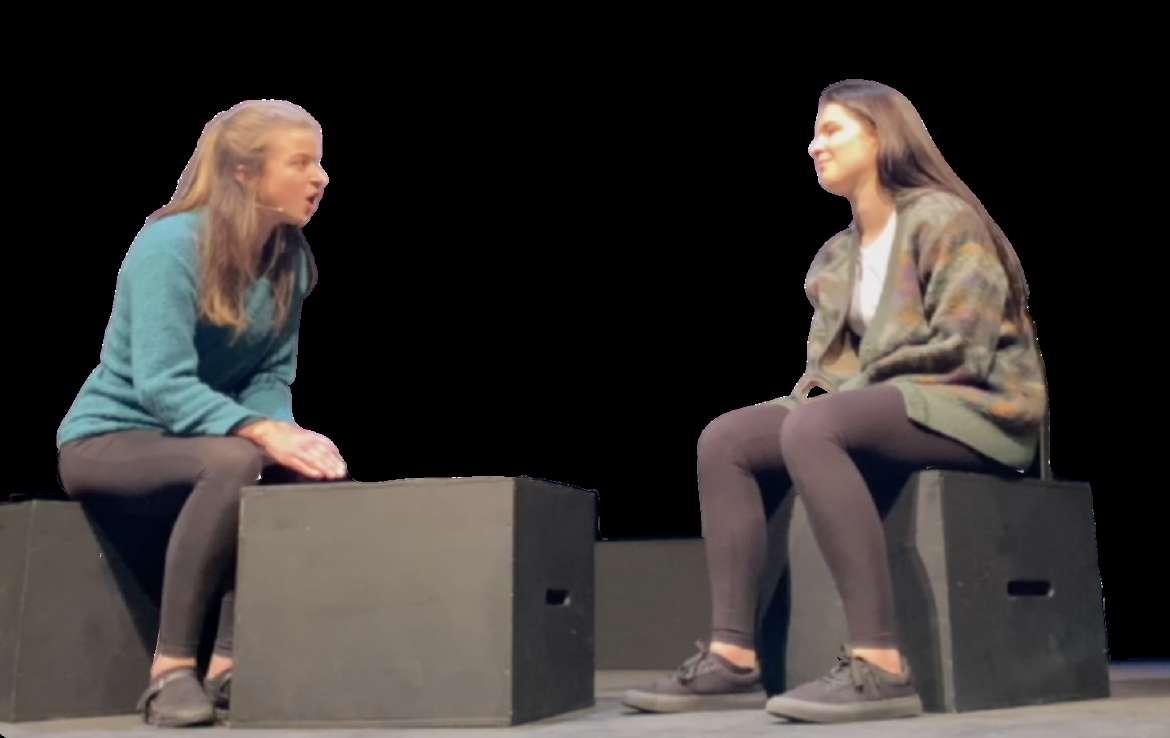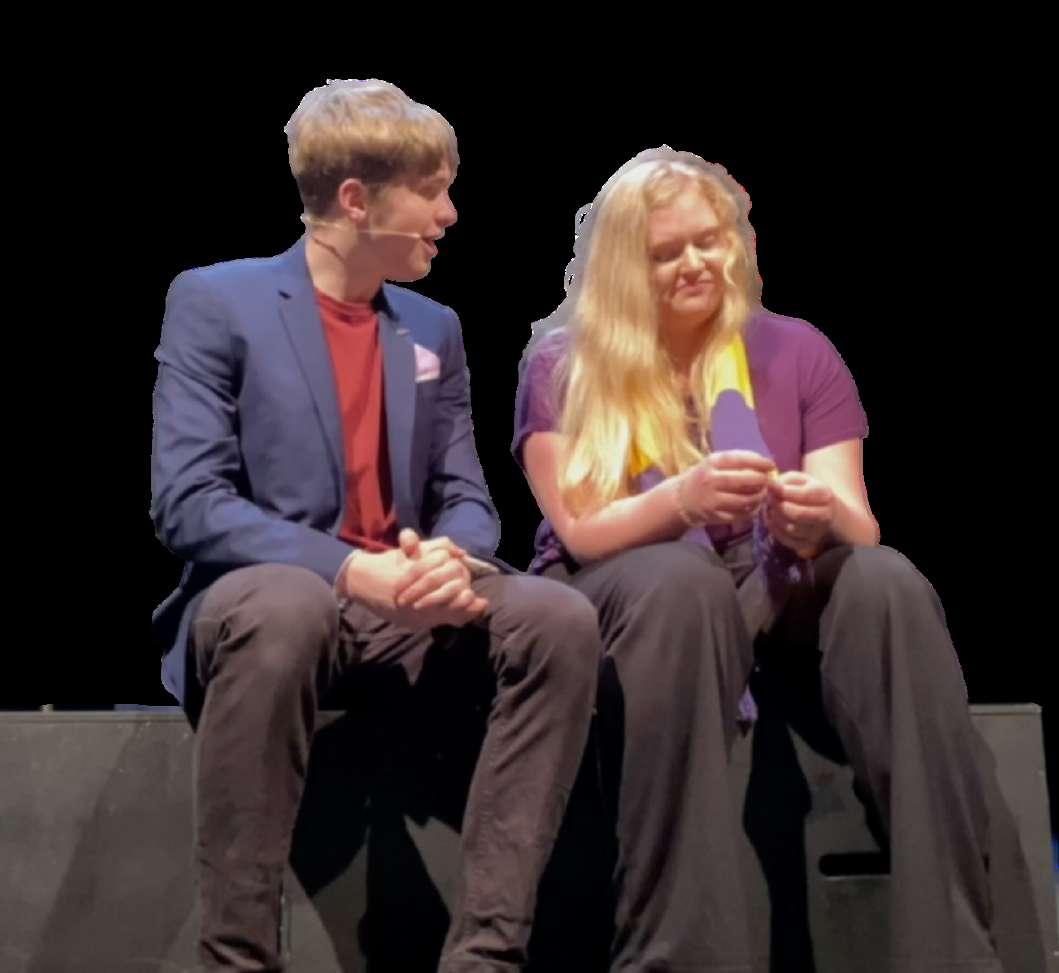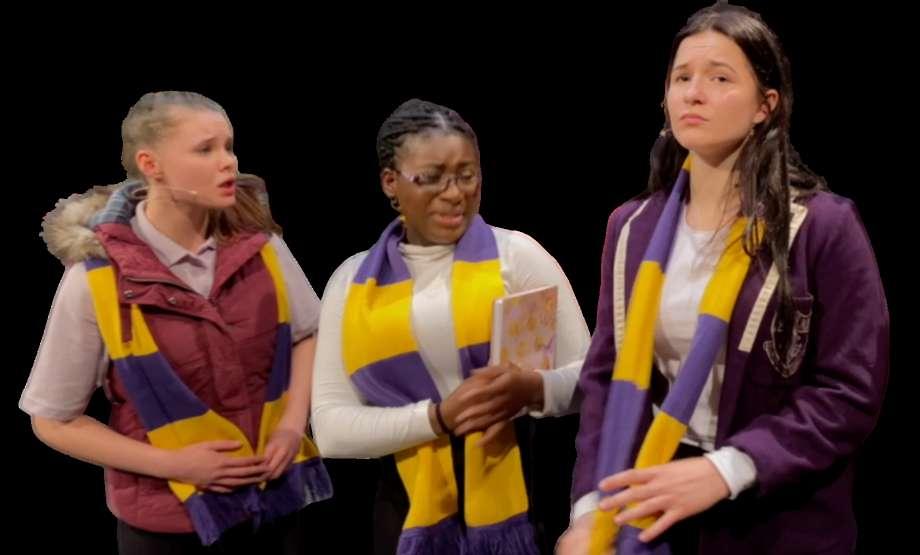
26 minute read
Quotes. Pages 40
"I mainly existed at the edge of things. I kept my head down, did my schoolwork, tried to make sure I didn’t draw attention to myself. I didn’t have friends, but I wasn’t bullied. No one was deliberately cruel. I wasn’t anything. I was just not really there.
PSHE Lessons
Advertisement
The digital production of Hidden is written as one continuous piece of 90 min drama. There is a suggested interval so it can be watched across two lessons. We recommend pausing at the end of Scene 20, “So where do you want to break the cycle” at 48:13.
Lesson 1 - Act 1
In this lesson, students will watch and respond to Act 1 of Hidden. Before starting to watch the play we would recommend reminding students of the Ground Rules and the trigger warnings. You can find a recap of the trigger warnings in a video by the cast here. Depending on the length of your lesson, the following questions can be addressed as discussion or as homework.
After watching Act 1 of Hidden, have you learned anything new about self-harm or mental health?
How can we support friends who might be self-harming?
How could Matt support Hayley?
How could Yas support Tash?
What steps did the different characters take to help them to stop self-harming?
Lesson 2 - Act 2
In this lesson, students will watch and respond to Act 2 of Hidden. Depending on the length of your lesson, the following questions can be addressed as discussion or as homework.
PSHE Lessons Myths about Self-Harm
There are many myths and misconceptions surrounding self-harm. These can be really unhelpful and can make it very difficult for young people to seek help. We therefore feel it is essential for schools to challenge these misconceptions to allow both those experiencing self-harm and their peers to understand themselves and each other better. In her book ‘Self-harm and Eating Disorder: A guide to whole school strategies and support’, Dr. Pooky Knightsmith debunks many of these myths. She has kindly agreed that we can reproduce extracts of her book here. Where we have used her work this is denoted with (DK). Artistic Director and writer Nina Lemon has also responded to some of these myths. Her responses are denoted with (PP).
Use this section in conjunction with Lesson 3 - Myths about Self-harm.
People who self-harm are attention seeking
DK Self-harm tends to fall into two broad camps: those who hide their injuries and those who don’t. Those who hide their injuries will often harm parts of the body which are least likely to be detected, such as the stomach or the tops of their arms and legs. These cases can go undetected indefinitely, often only coming to our attention if a disclosure is made. Conversely, some people who self-harm will not attempt to hide their injuries and may be judged as ‘flaunting’ them. Rather than dismissing this as attention-seeking behaviour, we should stop and ask ourselves, ‘Why is this student seeking attention? What are they trying to communicate?’
People who self-harm want to kill themselves
DK Many people believe that all acts of self-harm have suicidal intent behind them. This belief is particularly strong in cases where a student uses cutting as a coping mechanism or takes a non-lethal overdose. This belief can lead to hysterical reactions to disclosures of self-harm. Whilst students who self-harm are more at risk of going on to contemplate suicide than their peers, especially if their underlying issues are not dealt with, about 90% of students who self-harm never contemplate suicide. In fact, many students talk about self-harm as a protective factor against suicide. When selfharm is used as a coping strategy to keep emotions and feelings in check, it can prevent difficulties from escalating to the point where they feel the need to take their own life 49
People who self-harm are doing it to fit in
DK For some students, group identity relies on self-harm - that is, those students who actively self-harm together (this is sometimes associated with Goth or Emo communities, or Justin Bieber fans). For these students, self-harm injuries may be worn almost as a badge of honour and there can be a degree of competition over the severity of the injury.
PP Whilst there may be an element of peer pressure involved in some cases of selfharm, it is dangerous to dismiss self-harming behaviour as nothing more than a fashion statement. For some vulnerable people who go on to self-harm privately and habitually, group self-harm is the catalyst which starts their behaviour. My experience is that teenagers can be extremely dismissive of self-harm as they often assume it is only associated with specific social groups with whom they may not share values or aspirations. Equally, young people who self-harm and don’t identify as a member of one of these groups can often not seek help for fear of being stigmatised or associated with a group with whom they feel no affinity.
People who self-harm are crazy
DK People who have never self-harmed find it very difficult to understand why somebody would purposefully hurt themselves and think that there must be something very wrong with someone who would choose to do so. However, we find it far easier to understand somebody coping with their emotions by eating junk food or drinking alcohol. Self-harm is simply an alternative coping mechanism and does not mean that someone is psychotic or crazy, as people often think.
DK Many sufferers describe self-harm as an addiction and find the cycle very difficult to break as they have no other means of coping with their overwhelming thoughts and feelings, other than hurting themselves. However, people who have not self-harmed do not understand the complex emotions and psychology underpinning each act of self-harm and assume it would be easy to stop. This is not the case, and expecting somebody to suddenly stop self-harming can be very dangerous. If we remove this means of coping then they may find themselves in a more desperate situation; it is at these moments that a sufferer’s thoughts are more likely to turn to suicide. Generally speaking, students who are suffering from either self-harm or an eating disorder find it difficult to stop unless there is a significant change in their underlying circumstances, or unless they receive support to develop healthier coping mechanisms and come to terms with their difficulties.
Lesson 3
PSHE Lessons
Split your class into five groups and provide each group with one of the myths about self-harm, the questions and the character sheet. Each group should be give 20 minutes to discuss before feeding back to the rest of the class.
MYTH 1 - People who self-harm are attention seeking.
Do you think there is any truth in this statement? Why might some people believe this to be true? Thinking about the 5 characters on your cards, do you think that they are motivated by seeking attention? Why do you think seeking attention is viewed as a bad thing to do? If you compare somebody who comes into school displaying signs of self-harm with somebody who comes into school with a cast on a broken leg, do you think differently about them? Why?
MYTH 2 - People who self-harm want to kill themselves.
Do you think there is any truth in this statement? Why might some people believe this to be true? Thinking about the 5 characters on your cards, do you think that any of these characters had suicidal intentions? What do you think you should do if you suspect a friend might be having suicidal thoughts?
MYTH 3 - People who self-harm are just doing it to fit in.
Do you think there is any truth in this statement? Why might some people believe this to be true? Thinking about the 5 characters on your cards, do you think that any of these characters selfharm because they want to fit in? What do you think you should do if you suspect a friend is feeling pressured by their peer group to self-harm?
MYTH 4 - People who self-harm are crazy.
Do you think there is any truth in this statement? Why might some people believe this to be true? Thinking about the 5 characters on your cards, do you think that any of these characters are ‘crazy?’ What do you think people mean by 'crazy'? Do you think it is a useful word to use?
MYTH 5 - People who self-harm can stop whenever they want to.
Do you think there is any truth in this statement? Why might some people believe this to be true? Thinking about the 5 characters on your cards, what do you think prevented them from stopping this behaviour? Thinking about the 5 characters on your cards what, if anything, do you think helped them to stop self-harming? What do you think you could do to support or help a friend to stop self-harming?
MYTH 1
Why might some people believe this to be true?
Thinking about the 5 characters below, do you think that they are motivated by attention seeking?




MYTH 2
Why might some people believe this to be true?





MYTH 3
Why might some people believe this to be true?





MYTH 4
Why might some people believe this to be true?
What do you think people mean by 'crazy'? Do you think it is a useful word to use?





MYTH 5
'People who self-harm can stop whenever they want to.
Why might some people believe this to be true?
Thinking about the 5 characters on your cards, what do you think prevented them from stopping this behaviour?
Thinking about the 5 characters on your cards, what, if anything, do you think helped them to stop self-harming?
What do you think you could do to support or help a friend to stop self-harming?





PSHE Lessons
This exercise can either be done in groups or individually. Allocate a mental health problem from the list below to each student/group.
Ask students to go away and research their given mental health problem in order to answer the following questions and present them back to the class.
Anxiety and panic attacks Depression Bipolar Disorder Eating Disorders Post Traumatic Stress Disorder (PTSD) Personality Disorders Schizophrenia Addiction Obsessive Compulsive Disorder (OCD)
How does this mental health problem typically affect people? How common is this mental health problem? How can people with this mental health problem get help/ treatment? Are there any factors that make someone more likely to experience this mental health problem? Do you think that any of the characters in the play had this mental health problem and if so, why?
PSHE Lessons
To avoid students encountering dangerous or misleading information online, we would recommend students use the following list of safe, reliable websites;
Be mindful of your groupings and your students’ needs. We have included quite a wide range of mental health problems here to enable you to avoid assigning an issue that might be particularly challenging to a specific student. If you have a student you are very concerned about, you may want to consider assigning them or their group the topic of stress. Whilst it is not a mental health problem in the same way, it does affect mental health and affects everyone to a greater or lesser degree. It may prove to be a less triggering topic for vulnerable students.
http://www.youngminds.org.uk - Young Minds - Mental Health Charity http://www.time-to-change.org.uk - Time To Change - Mental health Charity http://www.mentalhealth.org.uk - Mental Health Foundation http://www.mind.org.uk - Mind - Mental Health Charity http://www.rethink.org - Rethink Mental Illness - Charity http://www.teenmentalhealth.org - (N.B. This is a Canadian site but we feel that the information is useful) http://www.charliewaller.org - Charlie Waller Memorial Trust Depression Charity http://www.b-eat.co.uk - B-Eat Eating Disorder Charity
PSHE Lessons
Lesson 5 - How to support a friend or relative who is selfharming
Split your class into pairs and assign one of the four scenes provided to each pair (scenes can be found via the links on each scene page that follows).
Ask the students to re-watch their assigned scene and to consider the questions for that scene. Notes to support the teacher with suggested answers have been provided.
Ask the students to consider how the characters might behave differently towards each other. If they and you feel comfortable, get them to improvise and perform scenes modelling alternative appropriate responses.
This exercise can also be undertaken as a whole class, with one group performing and the questions opened out for all of your students to answer and discuss.
Notes for Teachers
Most teenagers who self-harm are more likely to confide in a friend than in an adult. The chances are, many young people who you teach are concerned about a friend but don’t know how best to support them. They may feel confused because, although they know that their friend needs help, their natural loyalty towards their friend makes them want to keep their secret. This often means that young people are struggling alone to support each other. By looking at the key scenes from the play provided, your students will be able to consider different ways of reacting and consider alternate ways to support and protect their vulnerable friends.
Matt & Hayley
Matt and Hayley at Thorpe Park. In this scene, Matt sees Hayley’s scars for the first time. He is shocked but doesn’t show it and asks Hayley if she wants to talk about it. He tells her she has to stop and Hayley believes he will help her and keep her secret. Hayley gives specific details of her self-harm which might be triggering for Matt. We find out later that this is indeed the case. The link for this scene is here.
Questions to ask your students:
How do you think Matt feels about Hayley and do his feelings change during the scene? Can you pick up on any clues that might suggest to you why Hayley self-harms? Look at Matt’s reaction when he sees Hayley’s scars. Do you think his reaction helps Hayley? What could Matt do differently to support Hayley? What effect does Hayley’s revelation have on Matt? Is there anything that Hayley could do differently to ensure that her revelation to Matt has a less damaging effect on him?

The Answers:
Matt & Hayley
Matt clearly has a crush on Hayley and feels closer to her after she tells him about her self-harm.
The answer is not clear in the text and crucially Matt never asks Hayley what has been upsetting her. She does mention problems with her Step-Dad’s kids and arguments with her Mum. Could this be the catalyst?
Matt does his best to be a supportive friend but struggles to know how best to support Hayley. Positively, he does encourage her to stop and reinforces her self-worth to an extent ‘He tells me I’m beautiful’ . Unfortunately, he makes a few mistakes too:
By telling her to stop, Matt does nothing to uncover the underlying reasons for Hayley’s self-harm and may imply that stopping is easy.
Although we know he think Hayley is ‘popular, pretty, smart’ she only hears him tell her that she is beautiful. By only emphasising her physical appearance, Matt may not actually be improving her overall self-esteem. He agrees to keep her secret and then doesn’t follow up with her. He should be encouraging her to get help and seek adult or professional advice and support.
Matt & Hayley
What could Matt do differently to support Hayley?
Matt should encourage Hayley to get help from a trusted adult. Matt should focus on Hayley’s strengths and personality rather than focusing on the self-harming behaviour. Matt could talk to Hayley about the underlying feelings that are leading her to selfharm rather than just focusing on the behaviour.
Matt suggests that hearing Hayley’s description of her own selfharm makes him consider self-harming himself.
Although we, as the audience, don’t hear it, we know that Hayley tells Matt the specific details of her self-harming behaviour. It would be safer for her to talk to her friend Matt about it without going into detail as the more specific the details the more likely they are to trigger self-harming behaviour in someone else.

Tash & Yas
In this scene, Yas discovers that Tash has been burning herself. Yas is shocked, angry and hurt and clearly wants Tash to stop. Yas suggests self-harm is about being cool, a fashion statement, attention seeking and extreme. Tash persuades Yas to keep her secret. The link to this scene can be found here.
Questions to ask your students:
How do you think Yas feels about Tash and do her feelings change during the scene? Can you pick up on any clues that might suggest to you why Tash self-harms? Look at Yas’ reaction when she sees Tash’s scars. Do you think her reaction helps Tash? What could Yas do differently to support Tash? Why do you think Yas is angry with Tash? Why do you think Tash thinks Yas is angry with her? Why does Yas suspect Tash is self-harming? Do you think she is right?

The Answers:
Tash & Yas
How do you think Yas feels about Tash and do her feelings change during the scene?
Although Yas really cares for her friend Tash she does not understand her behaviour. She becomes increasingly frustrated with Tash when Tash refuses to get help for her self-harming behaviour.
Can you pick up on any clues that might suggest to you why Tash self-harms?
Tash struggles to articulate the reasons why she self-harms, perhaps because she herself doesn’t understand. She does say ‘it just makes me feel better sometimes’. Here she is referring to the immediate benefit it gives her but Yas dismisses it.
Look at Yas’ reaction when she sees Tash’s scars. Do you think her reaction helps Tash?
Yas is very angry which Tash finds difficult. She tells Tash that by burning herself she is hurting her friend and this makes Tash feel even worse.
What could Yas do differently to support Tash?
On the positive side, Yas does make it clear that she cares for her friend. Unfortunately, she makes a few mistakes too:
She is very angry. She promises not to tell anyone and then she tacitly agrees to keep it a secret even though she is very concerned about Tash. She assumes that Tash is just self-harming to fit in. She makes Tash feel worse by focusing on how much Tash’s behaviour is hurting Yas.
Tash & Yas
Why do you think Yas is angry with Tash?
Yas feels angry because she doesn’t understand. Her view of Tash is very different to Tash’s view of herself and this means it’s difficult for Yas to understand why Tash hurts herself.
Why do you think Tash thinks Yas is angry with her?
Tash has very low self-esteem so thinks that Yas is angry because Tash is stupid and worthless and pathetic.
Why does Yas suspect Tash is self-harming? Do you think she is right?
Yas thinks Tash is self-harming to fit in. This is not true.

Tash and her Mum
In this scene Tash’s Mum is trying to have a conversation with Tash about her self-harm but it descends into an argument. The link to this scene can be found here.
Questions to ask your students:
How do you think Tash’s Mum feels about Tash and do her feelings change during the scene? Do you think that Tash’s Mum’s reaction to Tash in this scene helps her daughter? Think about Tash’s Mum’s line "This has to stop. You have to stop doing it. " . How do you think this line makes Tash feel? Why do you think that Tash struggles to talk to her Mum and then walks out? What could Tash’s Mum do differently to support Tash?

The Answers:
Tash and her Mum
Tash’s Mum is extremely worried about her daughter but struggles to know how to help her. She starts calm but becomes increasingly frustrated by the situation.
Whilst Tash’s Mum tries to show her daughter that she cares, the way she goes about it is understandable but unhelpful. For example:
She pushes her daughter to talk to her when she is clearly uncomfortable. She has been through Tash’s things and admits this which makes Tash defensive. Tash’s Mum’s emphasis on stopping the behaviour rather than exploring the cause of Tash’s behaviour makes Tash uncomfortable and stressed. Tash’s Mum’s emphasis on self-harm not being normal further alienates her daughter.
By only focusing on the behaviour and not the cause, Tash feels backed into a corner. She does not know how to stop, so asking her to do so is futile and further reinforces her belief that she is a failure. 67
Tash and her Mum
Tash’s Mum inadvertently reinforces many of Tash’s negative beliefs about herself and makes her feel unsupported. In the play we know that she fears that she is the cause of her Mum’s unhappiness and she does not know what to do to change this.
She could de-escalate the situation by giving Tash space to calm down and suggest that they talk later. She could try to encourage her daughter to talk to someone, even if that person isn’t her. She could also seek professional support for Tash to cope with the trauma from her childhood which seems to be overlooked and not properly dealt with. She could focus more on what might be leading Tash to self-harm rather than only focusing on the self-harming behaviour.

Sophia and her Dad
In this scene, Sophia’s Dad visits Sophia at the Boarding School and seems to have all the answers. He doesn’t listen to her and suggests that school is safer than home and that this will all blow over in a few weeks. The link to this scene can be found here.
Questions to ask your students:
How do you think Sophia feels during the scene? Can you pick up on any clues that might suggest to you why Sophia self-harms? Look at Sophia’s Dad’s reaction to his distressed daughter. Do you think his reaction helps Sophia? What could Sophia’s Dad do differently to support Sophia? Looking at the scene, how many times does Sophia’s Dad dismiss her feelings? How do you think this makes Sophia feel?

The Answers:
Sophia and her Dad
How do you think Sophia feels during the scene?
Sophia feels completely disempowered because no one is listening to her or acknowledging her concerns. Her Dad controls the conversation and she feels ganged up on by her teachers, parents and peers.
Sophia never actually admits self-harming in the scene nor does she explain why. It is clear that she feels she has no control and also that she feels that her peer group don’t like her.
No. He doesn’t appear to hear her concerns and dismisses her persistent requests to come home. He makes her feel like everyone has been talking about her behind her back.
Sophia’s Dad could listen to his daughter’s worries, fears and anxieties and involve her in planning how to move forward.
Sophia feels completely helpless as no one is taking her concerns, worries or fears seriously. She feels very isolated.
Additional Insights
PSHE Lessons
Matt and Hayley
For Matt
Encourage Hayley to get help from a trusted adult
Focus on Hayley’s strengths and personality rather than focusing on the self-harming behaviour (TALK TO THE
PERSON NOT THE ILLNESS)
Focus on Hayley’s feelings that are behind the behaviour, rather than just focusing on the behaviour.
Try not to give specific details about her ways of self-harming as this can be triggering.
It is easy to get drawn into secrecy and you might think you are being a good friend, however, you are being a better friend by encouraging them to get help. Self-harm gets more addictive the longer it goes on. Guilt and shame will make your friend feel worse. Again, try talking to the person not the illness. It’s ok to say you don’t understand but you do want to help:
I want to help but I don’t know how”
What can I do to help?”
Would you like me to come with you to talk to (parent/teacher etc)?”
For Hayley
Tash and Yas
How to be a better friend:
Tash and Tash's Mum Tash’s Mum could try:
PSHE Lessons
Non-judgemental listening with lots of reflections, thereby making sure she is really listening to her daughter with open questions such as “Help me understand” whilst perhaps acknowledging some of Tash’s childhood trauma. Affirmations - for example, noticing that Tash has the courage to talk about how she is feeling “my whole life I’ve felt like I’m numb, stuck in some kind of fog”. Offering Tash a hug and acknowledge her pain, and letting Tash calm down. “I can see you are really upset right now and that this isn’t the right time to talk. You know I am always here for you if you want to talk.” Asking Tash if there is anything she could do differently that would be helpful. Finding out what professional help is available and helping Tash to access it when she is ready.
Collaborative Care - young people who feel that everyone is working together and that they are at the centre of the care plan are much more likely to feel supported and hopeful for their recovery. Where possible it is so much better if the school, parents and anyone else in the care team can show that they are prepared to listen to the young person involved to establish the best approach. The young person should be given the opportunity to talk about what has gone wrong and what might make things better. Acknowledging the challenges of recovery and helping create a step by step approach is more likely to be successful than trying to force through a quick fix approach, or assuming the issue will pass or is only a phase.
Sophia and her Dad
PSHE Lessons
Lesson 6 - Understanding our own self-worth
Ask your class the question ‘What is self-worth?' . Ensure that everyone in the class understands what we mean by self-worth. Ask your class to consider in groups what factors contribute to a sense of self-worth. Get each group to feedback their thoughts to the rest of the class. Give your students the character cards and the Self-Worth Factors sheet. Ask your students to add any of their own factors to the list. Which of these factors do you think are the most important and why? (N.B. There is no right or wrong answer, but it could help both student and teacher to identify what is more important to your students) Assign each small group a character card from the play. Which factors do you think affect the character’s sense of selfworth and why? Get each group to feedback their thoughts to the rest of the class.








